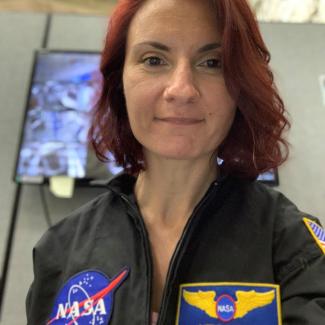Interview from October 2023

Geologist Dr Sandra Herrmann has had an impressive career. She has always been looking for new challenges. After she finished her Master’s degree at the TU Bergakademie, her path led her to ETH Zurich, where she completed her doctorate degree in natural sciences and worked at the earth science museum focusTerra afterwards. She then transitioned to the International Ocean Discovery Program that operates the scientific drilling vessel JOIDES Resolution and onward to NASA's Human Exploration Research Analog program HERA.
You studied in Freiberg. Why did you choose TU Bergakademie as your place of study?
When I was in school, I was always very interested in the natural sciences, especially geography and biology. A job research center in my hometown indicated that a geology degree program could be a perfect follow-up education based on these interests. I visited the TU Bergakademie Freiberg that year during Campus Day and was impressed by the diversity of the degree program and the charm of the mining town Freiberg.
What did you learn during your studies in Freiberg that particularly helps you in your current (research) work?
Diversification - I always found it hard to commit to one direction only. As a student, I was fortunate enough to work and perform research in different areas of the Geological Institute. My Master’s thesis was the only one in paleobotany at our institute at the time. Since completing my Master’s at the TU Freiberg I have continued to look for challenges in many different areas. I persued a PhD thesis on single celled plankton at the ETH Zurich in Switzerland including an expedition on the research vessel JOIDES Resolution to collect samples; a wonderful time at the geological museum focusTerra in Zurich and then the jump to the USA to work as a research assistant on the aforementioned research vessel at the International Ocean Discovery Program (IODP).
During my time with IODP, I was always trying to gather new knowledge. On one of the trips, I heard about the concept of "Analog Astronaut" and investigated the idea. There are a handful of these analogs in the world, including NASA's Human Exploration Research Analog at the Johnson Space Center in Houston. I was fascinated by the idea of exploring human frontiers in to advance the future of humanity as an interplanetary species. My application and the subsequent excitement of being selected as a candidate for a mission was another diversification milestone including pushing my own comfort zone once again.
What lasting memories do you associate with your time at the TU Bergakademie Freiberg?
The camaraderie in the institute and between the students. Although the geosciences at the TU Freiberg collaborate worldwide with other universities and the institute offers various specializations, it still feels more like a family in the laboratories and working groups. The team spirit, the joint work and the approachability of the faculty members makes the atmosphere unique.
What advice would you like to give to the current students in Freiberg?
Follow your dreams and ignore the Nay-sayers. If it would be easy, everyone would do it. Trust yourself, blow your path and don’t let anyone tell you that you are not made for the challenge.
What do you find particularly interesting about your current job?
The Analog Astronaut Mission at NASA was a unique experience. The work varied and included plant observation in botany, augmented reality and stress testing with unpredictable habitat changes. The work at IODP is fantastic. I work on the ship and in the office between expeditions. On the ship I met international scientists who became close friends. The work touches many labs, techniques and computer programs. There is always something to learn.
Finally, can you tell us your motto in life?
Dream big and work hard – it might get you to the stars.